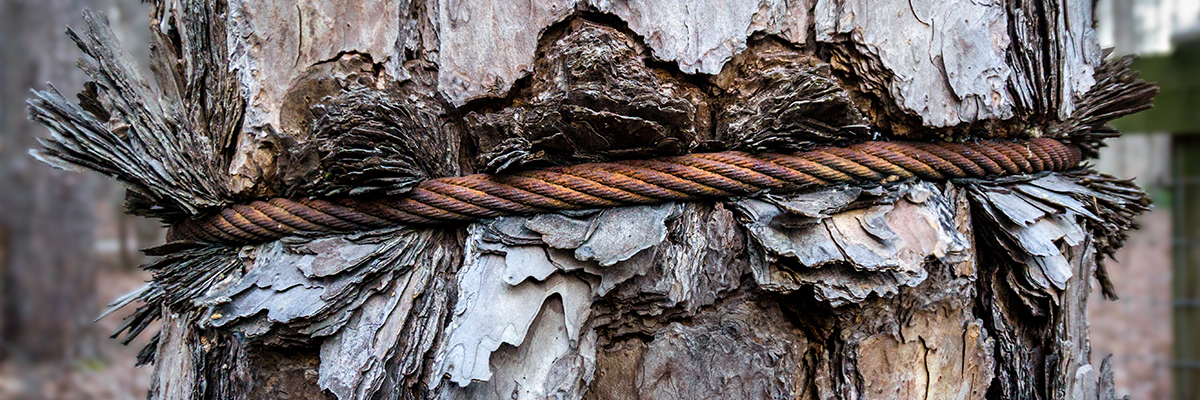You just brought a beautiful new tree home from the nursery and plant it in the perfect spot in your yard, excited for the lifetime of memories you and your family will make under the luscious shade of its leaves. You want to remember what species you got, so you leave the plastic nursery tag on. You notice a stake attached to the trunk and assume it’s supporting the tree, so you leave it attached, too. A week later, despite that stake you left on, you notice the tree is leaning so you add your own stake and use some old wire you have on hand for a tie. The stake from the nursery is attached extremely tightly by tape, so you follow their lead and tighten your wire as much as possible. Afterall, you love your little tree and want to give it as much support as you can.
You spend the next 2 years caring diligently for your new tree. You water it weekly, keep it properly mulched, and make sure not to get your lawn equipment too close to its delicate trunk. Yet, despite all of your love and care, your new tree starts to decline. The tree appears to be slowly dying from the top down. Your neighbor, a master gardener, thinks it’s drought stress and recommends extra watering.You provide extra watering all season, but it continues to decline. The next spring, your tree does not produce any leaves.
Fearing the worst, you call your community forester to come take a look. When they inspect your tree up close, they notice the trunk tissue bulging out around the wire from your stake, the tape from the nursery stake, and the plastic species tag you left on. They confirm your biggest fear – your young tree has died. Cause of death? Girdling.

By Autumn Weir. Autumn is a Heartland Tree Alliance Program Coordinator.
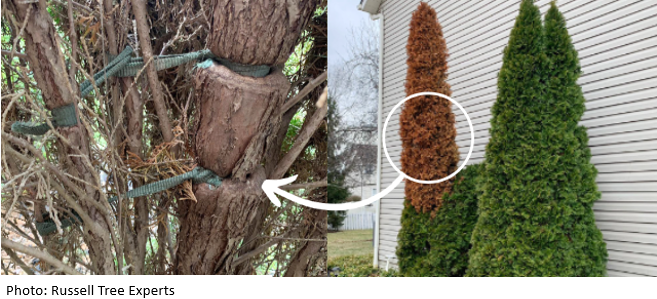
This is a tragic story we see played out too often: trees girdled and killed simply by the tags or stakes left attached to them for too long. The definition of girdling is “cutting through the bark all the way around a tree, typically in order to kill it”. While this can be done intentionally to, say, kill an invasive tree, it is often done on accident to trees that we very much would like to see live long and happy lives. Thankfully, there are easy ways to prevent this story from repeating itself!
When you plant, remove all the tags and other plastic you see on the tree. If you prefer to keep the species tag it on, make sure it is only around a lower branch, not the trunk, and is attached loosely. Trees are often sold with plastic or bamboo stakes attached to the stem by plastic tape. Always remove these stakes at the time of planting as they no longer provide adequate support once your tree is removed from the nursery pot. In fact, unless you perform significant root pruning or are planting in a windy location, your tree will grow stronger without any staking at all. If you do need to stake your young tree, it is best to use 2 stakes on opposite sides of the tree. Make sure you use a soft material, such as twine or cloth, so that it doesn’t cut into the bark of the tree. You can also use wire with 3”-4” of old hose covering the portions that rest on the trunk to avoid permanent damage. Make sure to keep the ties loose enough that the trees can still sway a bit in the wind. Keeping the ties slightly loose ensures that your tree is still working to grow a strong and stable root system. It also ensures that the ties can remain there for up to 2 years without risk of girdling your young tree. After 1-2 years, your tree should have an established enough root system that you can remove the stakes altogether.

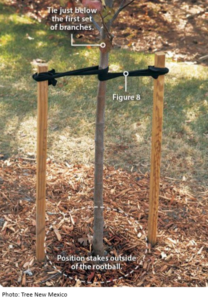
The tree’s own roots can also girdle the trunk even if you take the care to remove all foreign objects at the time of planting. Trees did not evolve to be grown in pots, and if they are kept in a pot for too long at the nursery their roots will start to grow in an unnatural circling pattern. Since this is an unnatural problem, trees are not able to naturally correct it on their own. It is important to address any circling or girdling roots with pruning at the time of planting. While it may feel wrong to cut up your baby tree’s roots, proper root pruning will ensure they don’t become a bigger problem later in the tree’s life. If left unaddressed, any circling roots can slowly girdle the tree and prevent water from being able to travel all the way to the top of the trunk, eventually killing it. Additionally, circling/girdling roots impact the tree’s ability to securely anchor itself into the ground. This can turn a perfectly healthy young tree into a potential hazard as it grows.

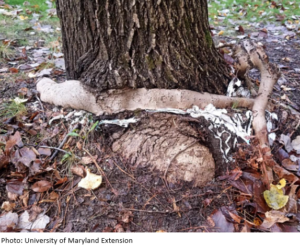
Although stake ties, nursery tags and roots are the most common things we see girdling trees, anything attached to a tree can become a problem. Christmas lights/ornaments, swings attached with rope or chain, and bird feeders are all examples of things we see girdling trees in our community. If you enjoy decorating your trees for the holidays, just make sure to remove everything at the end of the season. If your tree is home to a well-loved tire swing or bird feeder, simply keep an eye on the tree and enlarge your ties/hooks when you notice the tree is starting to outgrow the current conditions. Healthy trees will grow in diameter every year so we recommend checking on those things at least once a year.
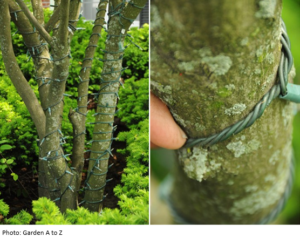
Girdling takes months or years to kill a tree – it takes us just a few minutes to rescue a tree from this tragic fate. Thankfully, if caught early, trees have a remarkable ability to recover from girdling. Take a closer look at the trees along streets in your neighborhood or in front of your favorite stores. If you find examples of girdling, either remove the threat or talk to the property owner to help them understand the dangers of girdling. Most of the time, folks are simply unaware and are happy to address the issue once they understand the problem. Afterall, nobody wants to be the person who accidentally loves their tree to death.

